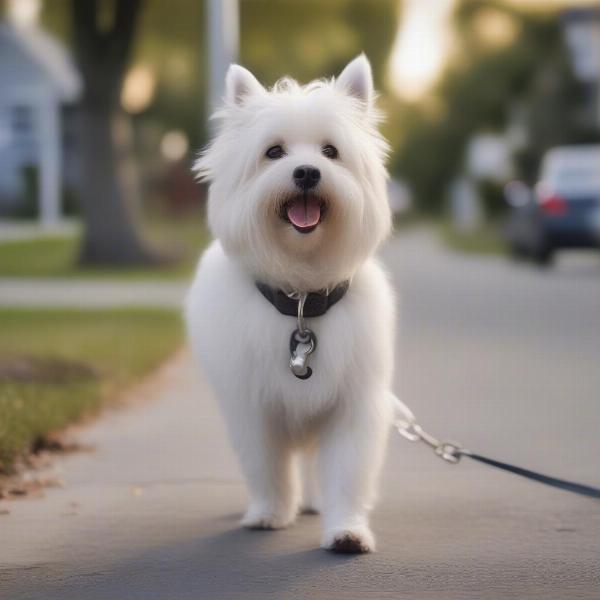Knowing how long your dog should rest after eating is crucial for their health and well-being. Exercising too soon after a meal can lead to serious problems like bloat, a life-threatening condition. This article will guide you on the optimal waiting time, factors influencing it, and how to keep your dog safe and happy after mealtimes.
Understanding the Risks of Exercise After Eating
Vigorous activity after eating can disrupt the digestive process. When a dog’s stomach is full, it can put pressure on the surrounding organs, and intense movement can cause the stomach to twist, leading to Gastric Dilatation-Volvulus (GDV), commonly known as bloat. This condition cuts off blood supply to vital organs and requires immediate veterinary attention. Even less strenuous activities can cause discomfort, vomiting, or regurgitation.
How Long Should You Wait?
A general rule of thumb is to wait at least one to two hours after feeding before engaging your dog in strenuous exercise like running, fetching, or intense play. For smaller breeds or dogs with sensitive stomachs, waiting a bit longer, even up to three hours, can be beneficial.
Factors Influencing Waiting Time
Several factors can influence the ideal waiting time:
- Breed Size: Larger, deep-chested breeds like Great Danes, German Shepherds, and Standard Poodles are more prone to bloat and may require longer rest periods.
- Age: Puppies and senior dogs have more sensitive digestive systems and may benefit from longer rest times.
- Type of Food: Highly processed or dry food tends to absorb water and expand in the stomach, requiring more time to digest.
- Individual Dog’s Metabolism: Some dogs digest food faster than others. Observe your dog’s behavior and consult with your veterinarian for personalized advice.
What to Do After Your Dog Eats
Instead of vigorous play, engage your dog in calm activities after mealtime. Short, leisurely walks, gentle petting, or quiet training sessions are suitable options. Provide fresh water to aid digestion and avoid giving treats immediately after a meal.
Signs of Bloat to Watch Out For
- Restlessness and pacing
- Excessive drooling
- Swollen abdomen
- Attempts to vomit without success
- Rapid breathing
- Weakness and collapse
If you notice any of these signs, seek immediate veterinary care.
Safe Playtime After Meals
Once the appropriate waiting period has passed, gradually introduce activity. Start with short play sessions and slowly increase intensity and duration. Always supervise your dog during playtime and ensure access to fresh water.
 Dog enjoying a gentle walk after a meal
Dog enjoying a gentle walk after a meal
Conclusion
Understanding how long to wait before playing with your dog after eating is essential for responsible pet ownership. By following the guidelines in this article and observing your dog’s individual needs, you can ensure safe and enjoyable playtime while minimizing the risk of bloat and other digestive issues. Remember to consult with your veterinarian for personalized advice tailored to your dog’s breed, age, and health condition.
FAQ
- How long should I wait to walk my dog after eating? A short, leisurely walk is generally fine 30-60 minutes after eating, but avoid strenuous exercise for at least 1-2 hours.
- What are the signs of bloat in dogs? Signs include restlessness, pacing, excessive drooling, a swollen abdomen, unsuccessful attempts to vomit, rapid breathing, weakness, and collapse.
- Can I give my dog a treat after eating? It’s best to avoid treats immediately after a meal. Wait at least a couple of hours.
- Is it safe to play fetch with my dog right after eating? No, avoid strenuous activities like fetch for at least 1-2 hours after eating.
- What kind of activities are safe after eating? Short, leisurely walks, gentle petting, or quiet training sessions are suitable options.
- Why are deep-chested dogs more prone to bloat? Their anatomy makes them more susceptible to stomach twisting.
- What should I do if I suspect my dog has bloat? Seek immediate veterinary care.
Related Articles
About ILM Dog
ILM Dog is your trusted international resource for expert dog care advice, covering everything from breed selection and puppy care to senior dog health and training tips. We provide practical, reliable information to help dog owners worldwide provide the best possible care for their furry companions. Our expertise spans dog breeds, health, training, nutrition, grooming, and product recommendations. For personalized guidance or to learn more about our services, contact us at [email protected] or call us at +44 20-3965-8624. Visit us online at ILM Dog for more valuable resources.